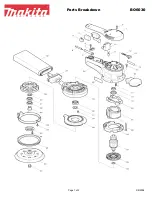
4.1.6. Turn the blade tension screw (fig. 6.1) anticlockwise to remove the tension and then carefully remove the blade.
4.1.7. Install the new blade. Be sure the teeth are pointing down in the cutting area.
4.1.8. To give the correct blade tension, turn the blade tension screw clockwise until you can no longer feel the spring load on the screw.
4.1.9. Rotate the upper wheel by hand - take care - to check that the blade runs in the centres of the three wheels. Adjust, if necessary, the
tracking screw (fig. 6.2).
4.1.10. Adjust the top and bottom support bearings so that they just touch the back of the blade and lock in place.
4.1.11. Adjust the four blade guides so that there is a gap of approximately 1mm between each guide and the blade. Lock in place.
4.1.12. Reinstall the upper blade guard. Note that the guard slides behind the head of the upper screw during vertical adjustment of the upper
guide and therefore the screw should not be tightened.
4.1.13. Refit the table and the front cover.
4.2.
Upper blade guide position
4.2.1. The upper blade guide should always be adjusted to about 3mm (1/8") above workpiece. To adjust, loosen the adjusting knob (fig. 6.3)
and slide the assembly to the required position. Tighten adjusting knob.
4.3.
Blade speed
4.3.1. Unscrew the two front cover retainers (fig. 1.B) and remove the
front cover.
4.3.2. Move the belt to the required position, see diagram.
4.3.3. Replace the front cover.
4.4.
Mitre gauge and fence
4.4.1. The mitre gauge, which locates in the table slot, is adjustable through 60
O
in either direction. Loosen the central locking knob, adjust
to the desired angle and then tighten locking knob.
4.4.2. The fence (fig. 7.1) is mounted on the table as shown and is locked in position with the locking screw (fig. 7.2).
4.5.
Belt sanding
4.5.1. Remove the saw blade and replace with the sanding belt, as detailed in 4.1.1. to 4.1.9. Ensure that the blade guides and support
bearings are locked in position
well clear
of the belt.
4.5.2. Fit sanding stop to table (fig. 8) and adjust so that it just touches the belt. Note that two stops are provided, one with a flat face and the
other with a curved face.
p
p
p
WARNING!
When sawing or belt sanding always ensure that the protective cover (fig.10.1) is in place over
the sanding disc.
5.1.
Cross cutting
To cut wood at right angles to the grain. This type of cut can be made freehand but using the mitre guide
ensures accurate results. The guide can also be adjusted to a 45° angle to produce mitre cuts, or compound mitre
cuts with the table tilted. Ensure the work is held firmly against the table and against the face of the mitre guide.
p
p
p
WARNING!
Keep your fingers away from the blade, particularly at the end of the cut.
5.2.
Freehand
When freehand cutting, select the widest blade suitable for cutting the smallest radius in the work you have
planned (see below). Always feed the work slowly to follow your saw line. Ensure you do not drag the work off-
line forcing the blade sideways or twisting it.
It may be helpful to make an initial rough cut about 5mm away from the line. For difficult curves which may be
too tight for the blade, make relief cuts on the face of the curve so that the waste wood will fall away as the
final radius is cut.
Blade width
Minimum cutting radius
1/8
5mm
1/4
16mm
3/8
35mm
5. OPERATING INSTRUCTIONS
SM1214 - 1 - 280801
fig. 6
fig. 7
fig. 8
4.6.
Circle cutting attachment
4.6.1. The circle cutting attachment is attached to the rear of the upper guide support
rod using the bracket and screw provided.
4.6.2. Start to cut into the workpiece at the perimeter of the required circle and then stop
saw and isolate from power supply.
4.6.3. Adjust circle cutting attachment so that pivot pin (fig. 9.A) is the required distance
(circle radius) from the blade and is in line with the blade teeth. Press point of
pivot pin into workpiece and tighten all cutting attachment locking screws (fig. 9.B).
4.6.4. Reconnect saw to the power supply and commence cutting whilst rotating the
workpiece about the pivot pin.
fig. 9
fig. 10
MOTOR PULLEY
BLADE PULLEY
160m/min
750m/min
1200m/min






















